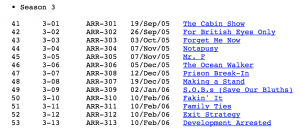Blog Post 2
(Lack of) Scheduling in relation to Arrested Development
Scheduling and routine have always been important parts of human life, especially in broadcast television, programs have always traditionally had a set timeslot each week, and people or families would timetable their evening around what TV shows they wanted to watch, and this routine or schedule would be relevant for a long time, until a season of a show finishes.
While regular scheduling can give a program an engaged audience who knows precisely when the next installment will appear, non regular scheduling can do the opposite, upset and frustrate viewers who have no idea when they should expect more content. This is especially true in a series that has over-arching plots and continuity between episodes, rather than standalone stories that can be viewed in any order and still make sense.
Arrested Development is an American sitcom created by Mitchel Hurwitz that follows the misadventures of the wealthy Bluth family. Arrested Development differed from most comedy programs of the era, Arrested Development was “a new kind of sitcom: one using a character narrator and an unlocked, hand- held camera, and one without a laugh track” (Barton 2015, pp 199). Its biggest difference was that the entire plot was conceived before production and it was to have a serialised structure so each episode would follow on the from the last.
While the show did contain a narrator that helped remind audiances of major plot points from earlier episodes, most of the smaller or “hidden” call-back jokes and foreshadowing was only noticed by those who had seen every prior episode and had a good memory of their content. To fully enjoy and appreciate the show, the audience needed to have regular interaction with the show, this is why scheduling is important.
Looking at this chart you can see that it was not infact given regular scheduling. Gaps between episodes up to 5 weeks long, a seemingly random distribution of 1-4 episodes on a single day.
If regular scheduling and routine are important for an enjoyment of a television program, then Arrested Development was doomed. Scheduling of TV has traditionally helped in organising our lives, as we base flexible activities around those which cannot change (i.e. a TV show’s timeslot). A show with set times that dont follow any reasonable organisation makes this impossible. A viewers could not, for example, create an evening timetable of watching television and include Arrested Development, as some weeks it was absent, and others it took up 4x its standard block.
Not only was show robbed of any reasonable flow between episode but it was also hampered by “Fox’s decision to air some of the episodes out of their intended order, causing confusion for a number of viewers.” (Barton 2015, pp 237).
Scheduling has been a cornerstone of Televison as a medium since its inception, but as much as a weekly burst of new content is associated with the traditional TV experience, the creators intentions or the fans enjoyment is null and void when compared to getting good ratings.
It is interesting (but probably unsurprising) to note, that Arrested Development’s 4th season was exclusively for Netflix, releasing every episode at the same time. That however, is enough content for an entire new blog post.
References:
Barton, KM 2015, A State of Arrested Development : Critical Essays on the Innovative Television Comedy, McFarland & Company, Inc., Publishers, Jefferson, N.C.
